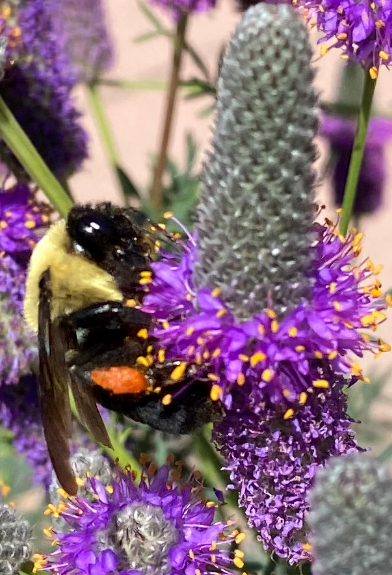2020 Native Bee Watch Citizen Science Project
- 2020-09-05
- By mkirk
- Posted in The Garden Buzz
By Sarah Viders, CSU Extension Intern

“They won’t sting you,” my friend said. There were so many bees flying all around me on a hike through the woods. I screamed and ran back to the car, but two weeks later, I mistakenly sat on a bee, revisiting my fear.
Everyone has a fear, right? I found a unique way to overcome it.
I was fortunate to be part of The Native Bee Watch Citizen Science Program at CSU Extension during the summer of 2020. The program delved into the biodiversity and abundance of bees affected by urbanization. As an intern working closely with Lisa Mason, Horticulture Agent in Arapahoe County, we helped volunteers with bee and plant identification, data entry, and created a pollinator community while providing education online.
NBW was a 100% virtual program that allowed more volunteers to participate. Upwards of 150 volunteers attended training to identify groups of bees on flowers in their own landscapes and then enter that data electronically to ArcGIS, a cloud-based, data sharing software.
Education was an important aspect of the program as it required volunteers to identify the different characteristics of bees, wasps, and flies. Here are some key differences:
- Wasps and bees have longer antennae than flies.
- Fly eyes are typically larger and extend to the top of the head versus bees that have eyes on the sides of their head.
- Wasps have more visibly cinched waists while bees do, but they are not as visible.
- Bees are typically fuzzy and have hairs on their bodies.
- Different bees carry pollen different ways:
- Many solitary bees carry pollen on their hind legs.
- Bees in the Megachilidae family (or the morpho species called “Hairy Belly Bees”) have pollen-collecting hairs on the underside of their abdomen.
- Honey bees and bumble bees have pollen sacs on their legs called corbiculae.
- Bees vary in color. Even honey bees have color variation from a very light color to almost black.
- Bees can see blue, yellow and ultraviolet.
- Check out this field guide for more tips.

Pollination by bees contributes $1.2-$5.4 billion dollars to American agriculture, “bringing us one of every three bites of food.” Native bees pollinate up to 180,000 different plants and reflect immense impacts on the ecology of the world. Everyone can help pollinators by planting flowers and providing habitat.

Pollinators are extremely necessary and important to our environment. Now that my internship has ended, I can happily say I have received no stings and welcome the sound of buzzing happily.
National Research Council. 2007. Status of Pollinators in North America. Committee on the Status of Pollinators in North America. Washington, DC: National Academies Press. http://www.nap.edu/catalog/11761.html
https://www.sciencedaily.com/releases/2020/03/200305002838.htm
Horticulture Resources
- Garden Buzz Archives
- CSU Extension Resources
- Colorado Master Gardener Program
- Foothills to Plains Native Plant Master Program
- Native Bee Watch Community Science Program
- The Co-Hort Blog
- PlantTalk Colorado
- Soil Testing
- Plant Select
- Emerald Ash Borer
- Japanese Beetle
- Colorado State Forest Service
- Ask an Expert


